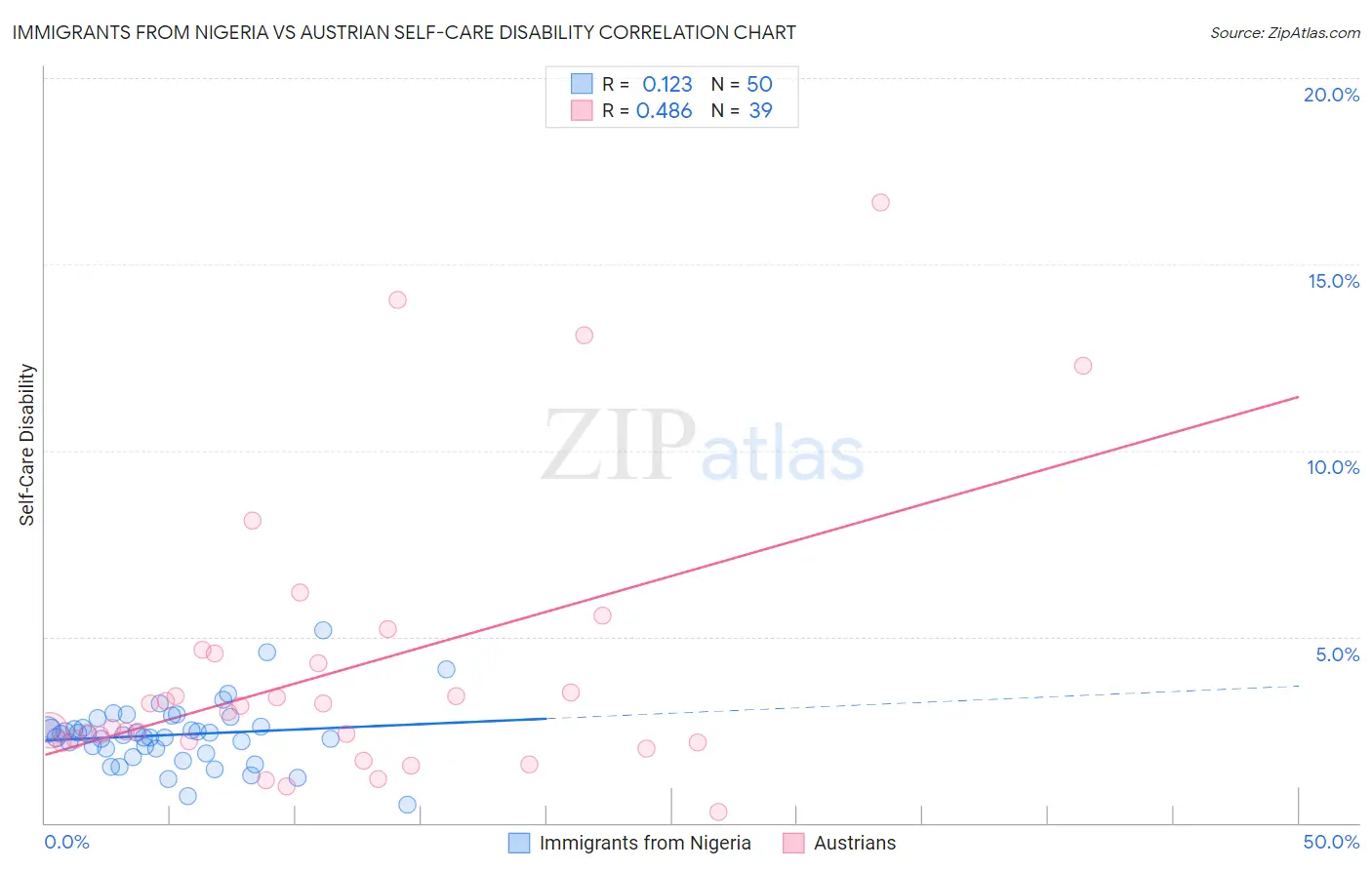Immigrants from Nigeria vs Austrian Self-Care Disability
COMPARE
Immigrants from Nigeria
Austrian
Self-Care Disability
Self-Care Disability Comparison
Immigrants from Nigeria
Austrians
2.4%
SELF-CARE DISABILITY
90.3/ 100
METRIC RATING
123rd/ 347
METRIC RANK
2.4%
SELF-CARE DISABILITY
87.0/ 100
METRIC RATING
137th/ 347
METRIC RANK
Immigrants from Nigeria vs Austrian Self-Care Disability Correlation Chart
The statistical analysis conducted on geographies consisting of 283,219,403 people shows a poor positive correlation between the proportion of Immigrants from Nigeria and percentage of population with self-care disability in the United States with a correlation coefficient (R) of 0.123 and weighted average of 2.4%. Similarly, the statistical analysis conducted on geographies consisting of 451,319,038 people shows a moderate positive correlation between the proportion of Austrians and percentage of population with self-care disability in the United States with a correlation coefficient (R) of 0.486 and weighted average of 2.4%, a difference of 0.40%.

Self-Care Disability Correlation Summary
| Measurement | Immigrants from Nigeria | Austrian |
| Minimum | 0.50% | 0.31% |
| Maximum | 5.2% | 16.7% |
| Range | 4.7% | 16.4% |
| Mean | 2.4% | 4.1% |
| Median | 2.4% | 3.0% |
| Interquartile 25% (IQ1) | 2.0% | 2.2% |
| Interquartile 75% (IQ3) | 2.6% | 4.6% |
| Interquartile Range (IQR) | 0.59% | 2.4% |
| Standard Deviation (Sample) | 0.85% | 3.7% |
| Standard Deviation (Population) | 0.84% | 3.7% |
Demographics Similar to Immigrants from Nigeria and Austrians by Self-Care Disability
In terms of self-care disability, the demographic groups most similar to Immigrants from Nigeria are Immigrants from Morocco (2.4%, a difference of 0.010%), Immigrants from North America (2.4%, a difference of 0.010%), Hmong (2.4%, a difference of 0.050%), Belgian (2.4%, a difference of 0.080%), and Colombian (2.4%, a difference of 0.080%). Similarly, the demographic groups most similar to Austrians are South American Indian (2.4%, a difference of 0.020%), Immigrants from Croatia (2.4%, a difference of 0.050%), Sri Lankan (2.4%, a difference of 0.050%), Laotian (2.4%, a difference of 0.080%), and Russian (2.4%, a difference of 0.14%).
| Demographics | Rating | Rank | Self-Care Disability |
| Uruguayans | 91.5 /100 | #120 | Exceptional 2.4% |
| Peruvians | 91.3 /100 | #121 | Exceptional 2.4% |
| Belgians | 90.9 /100 | #122 | Exceptional 2.4% |
| Immigrants | Nigeria | 90.3 /100 | #123 | Exceptional 2.4% |
| Immigrants | Morocco | 90.2 /100 | #124 | Exceptional 2.4% |
| Immigrants | North America | 90.2 /100 | #124 | Exceptional 2.4% |
| Hmong | 89.9 /100 | #126 | Excellent 2.4% |
| Colombians | 89.7 /100 | #127 | Excellent 2.4% |
| Immigrants | Hungary | 89.6 /100 | #128 | Excellent 2.4% |
| Immigrants | Romania | 89.3 /100 | #129 | Excellent 2.4% |
| Immigrants | Austria | 89.0 /100 | #130 | Excellent 2.4% |
| Poles | 88.9 /100 | #131 | Excellent 2.4% |
| Immigrants | South America | 88.8 /100 | #132 | Excellent 2.4% |
| Immigrants | Colombia | 88.5 /100 | #133 | Excellent 2.4% |
| Russians | 88.2 /100 | #134 | Excellent 2.4% |
| Laotians | 87.8 /100 | #135 | Excellent 2.4% |
| South American Indians | 87.2 /100 | #136 | Excellent 2.4% |
| Austrians | 87.0 /100 | #137 | Excellent 2.4% |
| Immigrants | Croatia | 86.6 /100 | #138 | Excellent 2.4% |
| Sri Lankans | 86.6 /100 | #139 | Excellent 2.4% |
| Immigrants | Uruguay | 85.4 /100 | #140 | Excellent 2.4% |